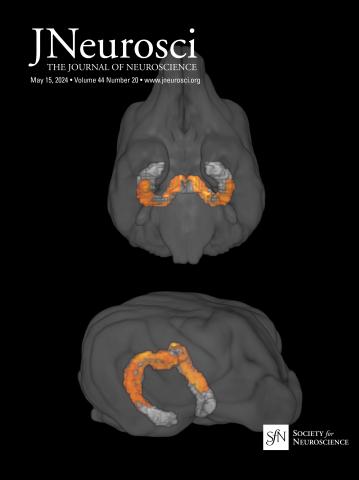视交叉上核中胃泌素释放肽产生神经元的功能作用:对光干扰和昼夜节律调节的见解。
IF 4
2区 医学
Q1 NEUROSCIENCES
引用次数: 0
摘要
视交叉上核(SCN)是哺乳动物的中央生物钟,在行为和生理上协调日常节律。在SCN中,胃泌素释放肽(GRP)产生神经元(GRPNs)主要位于核心区域,提示它们可能参与光掺杂。然而,GRPNs对昼夜节律调节的具体贡献仍然知之甚少。本研究利用Cre驱动小鼠品系Grp-iCre敲入(KI)小鼠,其中Cre重组酶仅在GRPNs中表达,允许选择性操纵SCN GRPNs以研究其特征和在昼夜节律调节中的功能作用。所有实验均在成年雄性小鼠中进行。解剖追踪显示,SCN GRPNs主要投射到丘脑和下丘脑,而输入映射显示,SCN GRPNs接受来自SCN内部的大多数突触输入。行为学分析显示,GRP缺乏或SCN GRPNs消融均未显著影响昼夜运动活动节律或光干扰。然而,对SCN GRPNs的化学发生刺激足以诱导行为节律的相移。此外,钙成像纤维光度法表明,SCN GRPNs对光刺激反应迅速,视网膜暴露于白光后神经活动增加。这些发现表明,SCN GRPNs在光夹带中发挥作用,尽管可能与其他神经元群(如血管活性肠肽产生神经元)冗余。意义声明视交叉上核(SCN)在哺乳动物中起着中央生物钟的作用,使内部节律与外部光暗周期同步。在其不同的细胞类型中,胃泌素释放肽(GRP)产生神经元(GRPNs)与基于光的夹带有关,但其具体作用尚不清楚。使用靶向遗传工具,我们证明这些神经元对视网膜光刺激反应迅速,当人工激活时,可以诱导行为节律的相移。然而,消除这些神经元并不会破坏昼夜行为或分子时钟节律,这表明SCN网络中存在功能冗余。我们的研究结果阐明了GRPNs在光诱导诱导中所起的调节作用(但并非必不可少),并强调了昼夜节律回路组织的复杂性和弹性。本文章由计算机程序翻译,如有差异,请以英文原文为准。
Functional Roles of Gastrin-Releasing Peptide-Producing Neurons in the Suprachiasmatic Nucleus: Insights into Photic Entrainment and Circadian Regulation.
The suprachiasmatic nucleus (SCN) serves as the central circadian clock in mammals, coordinating daily rhythms in both behavior and physiology. In the SCN, gastrin-releasing peptide (GRP)-producing neurons (GRPNs) are predominantly located in the core region, suggesting their possible involvement in photic entrainment. However, the specific contribution of GRPNs to the regulation of circadian rhythms remains poorly understood. This study utilized a Cre-driver mouse line, Grp-iCre knock-in (KI) mice, in which Cre recombinase is exclusively expressed in GRPNs, allowing the selective manipulation of SCN GRPNs to investigate their characteristics and functional roles in circadian regulation. All experiments were conducted in adult male mice. Anatomical tracing revealed that SCN GRPNs primarily project to the thalamus and hypothalamus, whereas input mapping demonstrated that SCN GRPNs receive most synaptic inputs from within the SCN. Behavioral analyses revealed that neither GRP deficiency nor ablation of SCN GRPNs significantly affected circadian locomotor activity rhythms or photic entrainment. However, chemogenetic stimulation of the SCN GRPNs is sufficient to induce phase shifts in behavioral rhythms. Additionally, calcium imaging with fiber photometry indicated that SCN GRPNs quickly responded to photic stimulation, with increased neural activity following retinal exposure to white light. These findings suggest that SCN GRPNs play a role in photic entrainment, albeit potentially redundant with other neuronal populations such as vasoactive intestinal peptide-producing neurons.Significance Statement The suprachiasmatic nucleus (SCN) functions as the central circadian clock in mammals, synchronizing internal rhythms with the external light-dark cycle. Among its diverse cell types, gastrin-releasing peptide (GRP)-producing neurons (GRPNs) have been implicated in light-based entrainment, but their specific roles remained unclear. Using targeted genetic tools, we demonstrated that these neurons respond rapidly to retinal light stimulation and, when artificially activated, can induce phase shifts in behavioral rhythms. However, eliminating these neurons does not disrupt circadian behavior or molecular clock rhythms, indicating functional redundancy within the SCN network. Our findings clarify the modulatory-but non-essential-role of GRPNs in light-induced entrainment and underscore the complexity and resilience of circadian circuit organization.
求助全文
通过发布文献求助,成功后即可免费获取论文全文。
去求助
来源期刊

Journal of Neuroscience
医学-神经科学
CiteScore
9.30
自引率
3.80%
发文量
1164
审稿时长
12 months
期刊介绍:
JNeurosci (ISSN 0270-6474) is an official journal of the Society for Neuroscience. It is published weekly by the Society, fifty weeks a year, one volume a year. JNeurosci publishes papers on a broad range of topics of general interest to those working on the nervous system. Authors now have an Open Choice option for their published articles
 求助内容:
求助内容: 应助结果提醒方式:
应助结果提醒方式:


